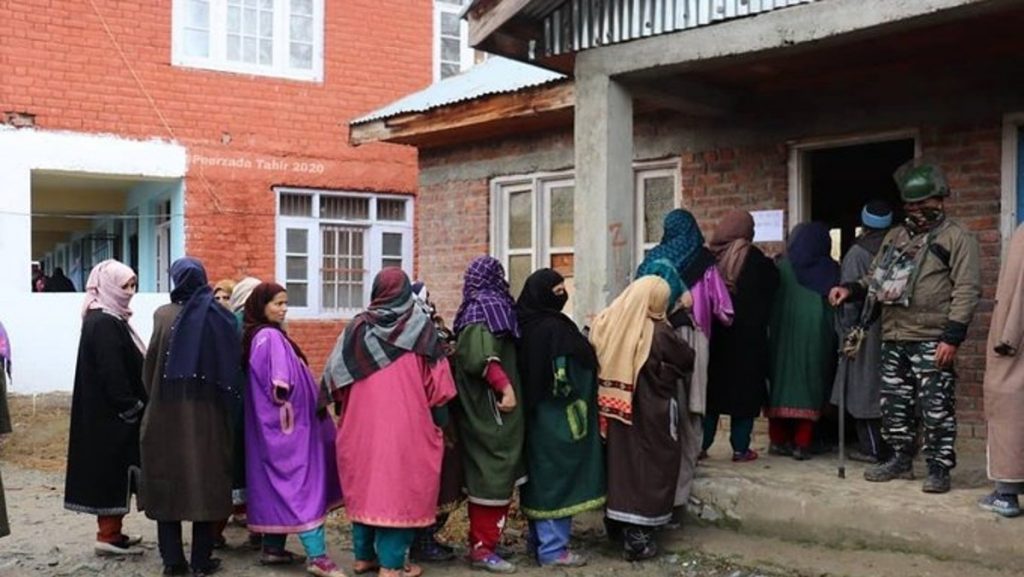Srinagar: The second phase of polling in the Jammu and Kashmir assembly elections saw a voter turnout of over 56 per cent on Wednesday, with the democratic exercise passing off peacefully amid tight security.
While there was significant participation in key constituencies in 26 seats spread over six districts with long queues of voters at polling stations since early morning, 20 of these segments recorded a marginally lower turnout than in the 2014 assembly elections, when the overall voting was 60 per cent.
The first phase of polling, held on September 18, saw an estimated 61.38 per cent voter turnout, while the final phase is set to take place on October 1 in the crucial elections being held after 10 years.
Jammu and Kashmir Chief Electoral Officer P.K. Pole announced a preliminary turnout figure of 56.05 per cent, stating that it might change as polling continued in some areas, including Hazratbal and Reasi.
He emphasised that the election proceeded smoothly, with only minor incidents reported.
“There were some stray incidents, but there is no need for re-polling anywhere,” Pole stated during a press conference after polls closed at 6 PM.
The highest turnout was recorded in the Shri Mata Vaishno Devi constituency, with 79.95 per cent of registered voters exercising their franchise. Other notable turnout figures included Kangan (71.89 per cent), Gulabgarh (73.49 per cent), and Surankote (75.11 per cent).
The Election Commission had set up 3,502 polling stations across the region, including 1,056 urban and 2,446 rural stations, with a robust security presence to ensure a safe voting environment.
Over 15,000 personnel, including local police and central paramilitary forces, were deployed to maintain order at the polling sites.
This phase saw a delegation of 16 foreign diplomats, including representatives from the US, Norway, and Singapore, visiting the valley to observe the electoral process.
This marked the first instance of international observers being allowed to witness elections in Jammu and Kashmir since the onset of militancy in the region.
The delegation visited multiple polling stations and expressed satisfaction with the conduct of the elections. US Deputy Chief of Mission Jorgan K. Andrews described the voting as “healthy and democratic,” noting the enthusiasm of voters after a decade-long pause in the electoral process.
“It is great to see the enthusiasm; it’s great to see Kashmiris out (and) voting after a pause for 10 years. We are very excited to see the results. It looks very healthy and very democratic,” Andrews told PTI Videos at a polling station here.
The US diplomat said the process here was similar to how it happens in his country.
The Ministry of External Affairs had invited diplomats from 16 countries to observe the exercise.
“They (diplomats) expressed overall satisfaction. Our officers explained to them about the overall process including arrangement,” Pole said.
However, the decision to invite foreign diplomats drew criticism from former chief minister Omar Abdullah, who questioned the necessity of foreign oversight in what he termed an internal matter.
Abdullah remarked, “When foreign governments comment, the Government of India says, ‘this is an internal matter for India,’ and now suddenly they want foreign observers to come and look at our elections.”
He criticised the government for what he perceived as a “guided tour” approach and called for consistency in policy regarding foreign involvement in domestic affairs.
Members of the visiting delegation appreciated the electoral process, with some diplomats expressing admiration for initiatives like the all-female managed “Pink polling stations.”
The delegation also interacted with local voters, who highlighted concerns about issues such as erratic electricity supply and rising bills.
“Electricity tariff meters have been installed. Now they say water consumption will also be metered,” a woman in her late 60s told a diplomat while waiting for her turn to vote at a polling station in the heart of Srinagar city.
While the woman refused to identify herself, she said she spoke her heart out hoping that there would be some relief for the poor people and that the “angrez” (foreigner) would take up the matter with the Centre.
South Korea diplomat Sang Woo Lim liked the idea of Pink polling station, an initiative of the Election Commission where polling stations are managed by all-female staff.
Singapore deputy head of the mission in Delhi Cheng Wei Wei Alice said it was wonderful to be part of the delegation observing the polls here. Alice said the delegates were “very thankful to the MEA for organising this trip and allowing us to visit the polling stations”.
The elections in Jammu and Kashmir continue to attract attention both domestically and internationally, as the region navigates its complex political landscape.
In Srinagar district, 93 candidates are vying for votes, followed by 46 in Budgam, 34 in Rajouri, 25 in Poonch, 21 in Ganderbal, and 20 in Reasi.
Prominent faces in this electoral battle include former Chief Minister Omar Abdullah, who is contesting from the Ganderbal and Budgam constituencies. Tariq Hamid Karra, the president of the Jammu and Kashmir Pradesh Congress Committee (JKPCC), is running for the Central Shalteng seat.
Ravinder Raina, the chief of BJP’s J-K unit, aims to retain his Nowshera seat in Rajouri.
Other notable candidates include jailed separatist leader Sarjan Ahmad Wagay, also known as Barkati, contesting from Ganderbal and Beerwah, and Apni Party president Altaf Bukhari, who is contesting in Channapora.
Former ministers such as Ali Mohammad Sagar (Khanyar), Abdul Rahim Rather (Chrar-i-Sharief), Choudhary Zulfikar Ali (Budhal), and Syed Mushtaq Bukhari (Surankote) are also in the running, with Ali and Bukhari standing on BJP tickets this time around.
PTI
